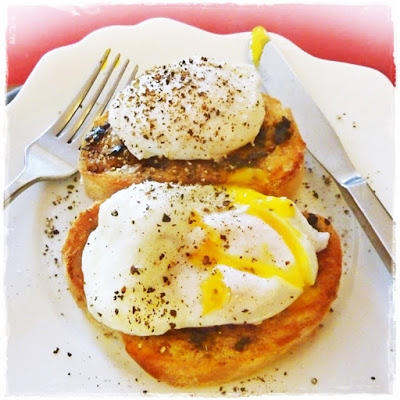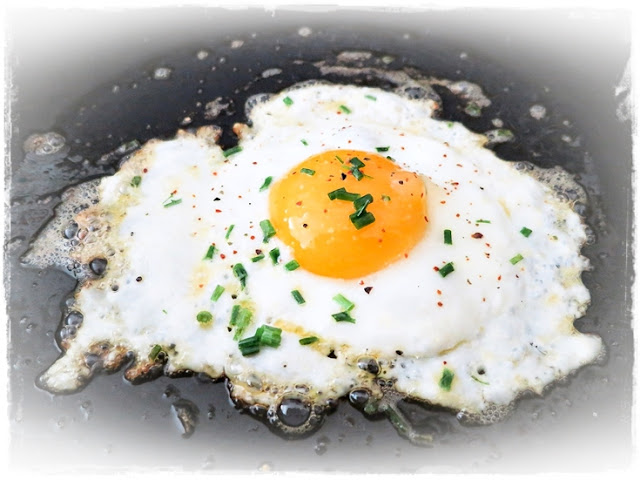In the States
eggs are kept in the fridge and I understand that European and American eggs
are treated so differently that our eggs would be illegal in the States and American
eggs would actually be illegal anywhere in the EU. Read more on how to store eggs here if you don't believe me!
In
America it is law that eggs be washed before being sold commercially, in the UK
it is the law that they must not be washed!
The reasoning behind these different laws are thus ...
 |
| Pin for future reference in case you move! |
~ The Americans’ take on the issue is that washing eggs makes them cleaner, which in principal one can’t argue with. The downside is that after washing the eggs must be dried very thoroughly indeed as any dampness will promote bacterial growth. Furthermore, because their natural protection has been washed off eggs in America are stored in the fridge and there is the danger that eggs may sweat when removed from the fridge, especially on the journey home from the shop, and bacteria will grow.
~ In the UK we prefer not to wash our eggs for
the above reasons, careless cleaning being more dangerous than no cleaning.
Washing also removes the cuticle which protects from contamination, it is
because we leave the cuticle on that we do not need to refrigerate eggs in the
UK.
Another
point in our favour is that since the 1990s our farmers have been routinely
inoculating hens against salmonella and it’s really worked. In the US eggs are
kept below 40oF to stop salmonella developing.
Why then, I ask
myself, and you, does my box of eggs from Tesco have “best kept refrigerated”
on it?
What a surprise! Have things changed and no-one has told me?
Apart from freeing up space in your fridge storing them un-chilled is a
boon when cooking as for best results they should always be cooked from room
temperature.
Speaking of eggs I just tried something silly ...
Hard “Boiled” Eggs in the Oven
~ Preheat the oven to 160ºC/325°F/140ºC
fan/gas 3.
~ Put 1 whole raw egg in each individual cup in a muffin tray.
~ Bake for 30 minutes.
~ Immediately immerse in a large dish of ice cold water.
~ When completely cold (about 10 minutes) peel and do with them what you will.
~ Put 1 whole raw egg in each individual cup in a muffin tray.
~ Bake for 30 minutes.
~ Immediately immerse in a large dish of ice cold water.
~ When completely cold (about 10 minutes) peel and do with them what you will.
When I saw this I wondered to myself “is this another of those daft hacks I’ve been seeing recently?” but
tried it anyway. And the answer to my
question?
In short – a definite yes; daft and pointless. In more detail ...
~ Preheating the oven and keeping
it on for 30 minutes is time consuming and costly compared to just boiling the
buggers. If you have the oven on already I suppose it might be economical but
not many things cook at such a low temperature.
~ The egg whites were discoloured, their texture was rubbery and they tasted strongly metallic/sulphurous.
~ The yolks tasted fine but seemed to have migrated to one side of the egg so not good for pretty presentation.
~ I noticed a distinct and long lasting eggy pong about the house which is not the case when boiling.
~ The egg whites were discoloured, their texture was rubbery and they tasted strongly metallic/sulphurous.
~ The yolks tasted fine but seemed to have migrated to one side of the egg so not good for pretty presentation.
~ I noticed a distinct and long lasting eggy pong about the house which is not the case when boiling.
Don’t try this at home – or anywhere else!
Why are such peculiar ideas becoming rife when there are easier, pleasanter,
safer, quicker, deliciouser ways to do things?
For more irritating “cooking hacks” see here.
Eggs are incredibly useful and versatile
so here’s some actually useful info, tips and
opinions about the most usual ways of cooking them.
How to Boil Eggs
"Put fresh eggs into cold water and allow them to
boil for the duration of a Paternoster, or a little longer"
Aldo
Buzzi
A Paternoster is the Lord’s Prayer which,
hang on a minute … took me 21.36 seconds of slow praying (I am always very
thorough in my research for this blog) and, that being the case, I think Mr.
Buzzi is very much in error. *** More information on this matter at the end of the post.
I do agree with him, however, that although eggs
can be boiled by plunging them into boiling water it is easier to do them well
from cold, like this ...
~
If you are in America bring your eggs to room temperature for two good reasons;
they can be timed more accurately and they are less likely to crack.
~ Put them in a small pan and add enough cold water to cover by about 1cm/½".
~ Bring to a boil over high heat then turn down the heat and simmer for the following times.
~ Put them in a small pan and add enough cold water to cover by about 1cm/½".
~ Bring to a boil over high heat then turn down the heat and simmer for the following times.
~ Very
soft boiled with a still runny white – 3 minutes
~ Soft boiled with a runny yolk but a set white– 4 minutes
~ Semi firm yolks – 5 minutes
~ Hard boiled with a tender yolk– 8 minutes.
~ Really hard boiled – 10 minutes
Here's a great way of serving soft boiled eggs ...
Oeufs Mollets
These are soft boiled eggs served in a creamy onion sauce. Read more about Oeufs Mollets here.
How to Scramble Eggs
I have never, ever whisked milk or cream into eggs for scrambling, they
are perfect just cooked with butter.
It is absolutely essential than any intended additions or
accompaniments are ready before you start scrambling.
~ Melt a generous knob of
butter (about 15g/½oz) over medium heat in a small pan – non-stick preferably
for washing up reasons.
~ Break two or three eggs directly into the partly melted butter and immediately stir the two together.
~ Season and stir constantly over a low-ish heat.
~ As the eggs start to solidify fold them into the uncooked egg till you have a pan of softly cooked eggs.
~ Immediately stir in a little more cold butter or some cream simply because this will stop the eggs continuing to cook, any added deliciousness is purely incidental.
~ Serve absolutely immediately.
~ Break two or three eggs directly into the partly melted butter and immediately stir the two together.
~ Season and stir constantly over a low-ish heat.
~ As the eggs start to solidify fold them into the uncooked egg till you have a pan of softly cooked eggs.
~ Immediately stir in a little more cold butter or some cream simply because this will stop the eggs continuing to cook, any added deliciousness is purely incidental.
~ Serve absolutely immediately.
Using a goodly amount of butter makes the eggs rich and creamy both in
taste and texture.
How to Poach Eggs
How to Fry Eggs
To fry an egg ...
~
Heat a tablespoon of oil or equivalent in butter (the egg will be more
tender if cooked in butter, more inclined to "puntillitas" or slightly crisp browned edges in
oil) in the middle of a preheated non-stick or well-seasoned frying pan.
~ Gently break the egg into the centre of the oil
~ Cook over medium heat for about a minute till the white is actually white and then do one of the following:
~ Gently break the egg into the centre of the oil
~ Cook over medium heat for about a minute till the white is actually white and then do one of the following:
~ For
sunny side up either serve as is or briefly cover the pan with a lid so that
the top of the yolk sets lightly in the steam.
~ For
slightly more set yolks, when the white looks pretty well cooked splash the hot
fat over the yolk till it assumes a glazed look.
~ For
over easy carefully flip the egg yolk side down and cook for about five seconds.
~ Over
hard are the same as above but cooked till the yolk is firm.
These crunchy breadcrumbs are known as Pangrattato - a quick, cheap, easy way to improve almost any meal!
How to make an Omelette
Omelettes are not as difficult as we have
been led to believe, in fact they are quite easy. This is how to make an
omelette for one person and as you should always make an omelette for just one
person this is all the info you need. For additional people make additional
omelettes, they only take a minute or two and work out much better than trying
to double up ingredients.
~ Break
2 or 3 eggs into a bowl.
~ Season and lightly beat together just to break the whites into the yolks, there is no need to whisk till fully amalgamated.
~ Melt a knob of butter in a 24cm or thereabouts non-stick pan.
~ When the butter has melted and starts to foam swirl it about the pan and pour in the eggs.
~ Allow to sit over the heat for a few seconds and when you see the edges start to solidify gently lift them with a spatula, tilt the pan towards the spatula and encourage the runny egg on top to flow to the side of the pan and under the cooked egg.
~ Keep doing this till the top of the omelette is merely moist.
~ Add any fillings and fold one half of the omelette over the other.
~ Slide onto a warm plate.
~ Season and lightly beat together just to break the whites into the yolks, there is no need to whisk till fully amalgamated.
~ Melt a knob of butter in a 24cm or thereabouts non-stick pan.
~ When the butter has melted and starts to foam swirl it about the pan and pour in the eggs.
~ Allow to sit over the heat for a few seconds and when you see the edges start to solidify gently lift them with a spatula, tilt the pan towards the spatula and encourage the runny egg on top to flow to the side of the pan and under the cooked egg.
~ Keep doing this till the top of the omelette is merely moist.
~ Add any fillings and fold one half of the omelette over the other.
~ Slide onto a warm plate.
You can add pretty well anything to the
middle of an omelette remembering to pre-warm most fillings first (not cheese)
as it will only be over the heat for a few seconds. I like to add crunchy croutons for a lovely texture contrast.
How to Bake Eggs
~ Preheat the oven to 180ºC/350°F/160ºC fan/gas 4.
~ Butter one ovenproof ramekin per egg
and break said egg into the ramekin.
~ Season to taste.
~ Pour over a tablespoon of double cream.
~ Bake the egg(s) for 15-20 minutes till the white is set and the yolk isn’t.
~ Serve with crisp hot toast for dipping purposes.
~ Season to taste.
~ Pour over a tablespoon of double cream.
~ Bake the egg(s) for 15-20 minutes till the white is set and the yolk isn’t.
~ Serve with crisp hot toast for dipping purposes.
You can bake eggs in other things too – eg.
a tart case, half a avocado, a bacon lined muffin cup or, as here, in a
tortilla lined ramekin.
More on timing boiled eggs!
*** Some years ago a reader wrote to the Daily Telegraph as follows …
"If you boil an egg while singing all
five verses and chorus of the hymn, 'Onward Christian Soldiers.' it will be
cooked perfectly when you come to Amen."
I think this may be a more reliable method
than the Lord’s Prayer.












2 comments:
I keep my Tesco eggs at room temperature and they're absolutely fine, I always find they last longer than their use by date too. I agree that the hard boiled eggs in the oven sounds like a ridiculous hack when it's so easy to do in a pan on the hob.
As most of America is much further south than England, I believe plays a larger part in the refrigeration issue. For instance, Dallas is just about the same latitude as Cairo.
Post a Comment